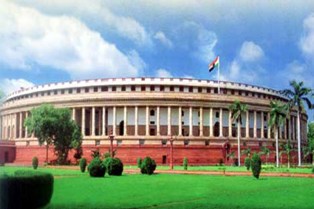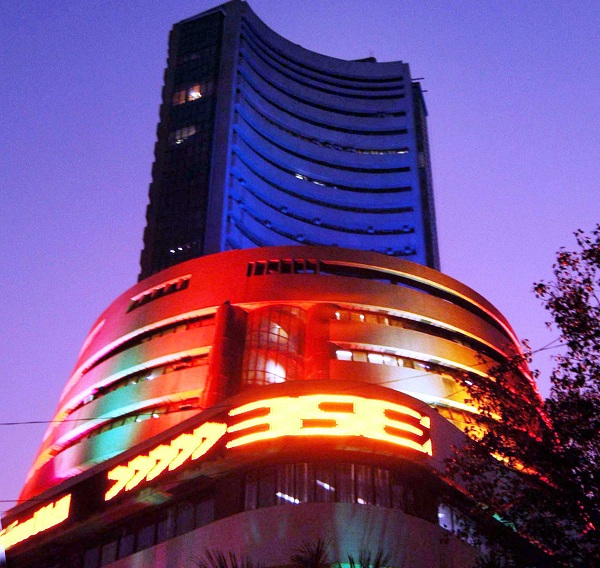
by admin | May 25, 2021 | News
 Mumbai:(IANS) The prevailing logjam in Parliament coupled with prospects of a US rate hike and the decline in oil and gas stocks subdued Indian equity markets on Tuesday leading to a barometer index trading 154 points down during the late-afternoon session.
Mumbai:(IANS) The prevailing logjam in Parliament coupled with prospects of a US rate hike and the decline in oil and gas stocks subdued Indian equity markets on Tuesday leading to a barometer index trading 154 points down during the late-afternoon session.
Initially, both the bellwether indices of the Indian equity markets opened on a negative note following their Asian peers.
Besides, prospects of a US rate hike prompted a selling frenzy among foreign investors and continued weakness in rupee’s value depressed investors.
In addition, oil and gas, energy and power companies stocks fell after a dip in global crude oil prices.
The barometer 30-scrip sensitive index (Sensex) of the Bombay Stock Exchange (BSE) shed 154 points or 0.60 percent during the late-afternoon session.
Similarly, the wider 50-scrip Nifty of the National Stock Exchange (NSE), was also trading in the red. It was lower by 39.15 points or 0.50 percent at 7,726.25 points.
The Sensex of the S&P Bombay Stock Exchange (BSE), which opened at 25,488.42 points, was trading at 25,391.04 points (at 3.00 p.m.) — down 154.07 points or 0.60 percent from the previous day’s close at 25,530.11 points.
The Sensex so far touched a high of 25,542.47 points and a low of 25,373.01 points during the intra-day trade.
Markets observers elaborated that the investors’ sentiments were subdued due to the logjam in parliament which has dimmed the prospects of the Goods and Services Tax (GST) bill getting passed during the winter session.
“The parliament’s logjam is a major dampener for the markets as it reduces the chances of the GST bill getting passed this session,” Anand James, co-head, technical research desk with Geojit BNP Paribas Financial Services, told IANS.
“The upcoming US rate hike, continued selling by the foreign investors in the Indian markets and the slump in oil prices which negatively impacted stock prices of oil and gas companies thinned investor participation.”

by admin | May 25, 2021 | Corporate, Corporate Reports

Bombay Stock Exchange(Photo;Maeeshat)
By Rohit Vaid
Mumbai:(IANS) The Indian equity markets made marginal gains during the weekly trade ended August 7, as investor sentiments were subdued on account of the central bank’s decision to keep key lending rates intact.
The barometer 30-scrip sensitive index (Sensex) of the S&P Bombay Stock Exchange (BSE) gained marginally by 121.83 points during the weekly trade ended August 7, 2015.
The index ended at 28,236.39 points in the week under review from the previous close of 28,114.56 points on July 31.
Slight gains at the Sensex came a week after the barometer index inched up by 2.25 points and closed at 28,114.56 points during the weekly trade ended July 31.
“There was an initial disappointment as investors expected a cut based on current data which showed that inflation is coming under control, stable macro fundamentals and falling crude oil prices,” Devendra Nevgi, chief executive of ZyFin Advisors, told IANS.
The Reserve Bank of India (RBI), in its third monetary policy review on August 4, kept the repurchase rate, or its short-term lending rate, unchanged at 7.25 percent.
The reverse repo rate, or the short-term borrowing rate, was unchanged at 6.25 percent.
The cash reserve ratio (CRR), or the liquid money banks have to compulsorily hold, stood unchanged at 4 percent.
The decision to maintain the status-quo disappointed investors, as a general consensus had appeared to show that the current review might be the last chance that RBI had to cut rates in this calendar year.
Markets are doubtful over the RBI’s ability for a future easing of the monetary policy in hindsight that inflation might spiral up again and the US Fed’s decision on its own rates is coming up in September.
“However, the markets soon assessed the positive aspect of the decision like the dovish language used by the RBI on the Indian economy, oil prices, monsoon, inflation and the US rate hike,” Nevgi observed.
According to Vaibhav Agarwal, vice president and research head at Angel Broking, “Positive cues were added by the RBI as its commentary suggested that if good monsoon, low inflation coupled with rupee stability and falling commodity prices continues then it can even go in for an rate cut.”
“Monsoon performance was also factored in. Good rainfall and higher cultivation has put to rest the monsoon worries that the markets had for now,” Agarwal told IANS.
Another positive point for the Indian market was the decline in commodity prices like oil and gold.
“We have a bearish outlook on commodity prices. They are not expected to bounce back any time soon. This is good news for India as it is a major consumer of oil and gold,” Agarwal added.
Anand James, co-head, technical research desk, Geojit BNP Paribas, told IANS that while the RBI’s decision to maintain rates was factored in, the real damage to the markets was caused by the stalemate in parliament.
“Investors were seen reluctant to chase higher prices given the possibility that the reform process might stall given the government’s inability to conduct business in parliament,” James elaborated.
The current parliament’s logjam has cast a shadow over the government’s ability to pass economic reforms. It has also put a question mark over the fate of key legislation like the GST (goods and services tax) and the land bill.
James pointed out that the markets were taking time to understand the impact that US non-farm payroll data might have on the US Fed’s decision on rate hike.
The US economy added 215,000 new jobs last month. In June the employment figures had gone up by 231,000, while during May it stood at 260,000.
The data point is significant — if it shows recovery in the US economy, then the US Fed is likely to raise interest rates in September.
With higher interest rates in the US, the FPIs (Foreign Portfolio Investors) are expected to be led away from emerging markets such as India.
(Rohit Vaid can be contacted at rohit.v@ians.in)

 Mumbai:(IANS) The prevailing logjam in Parliament coupled with prospects of a US rate hike and the decline in oil and gas stocks subdued Indian equity markets on Tuesday leading to a barometer index trading 154 points down during the late-afternoon session.
Mumbai:(IANS) The prevailing logjam in Parliament coupled with prospects of a US rate hike and the decline in oil and gas stocks subdued Indian equity markets on Tuesday leading to a barometer index trading 154 points down during the late-afternoon session.

